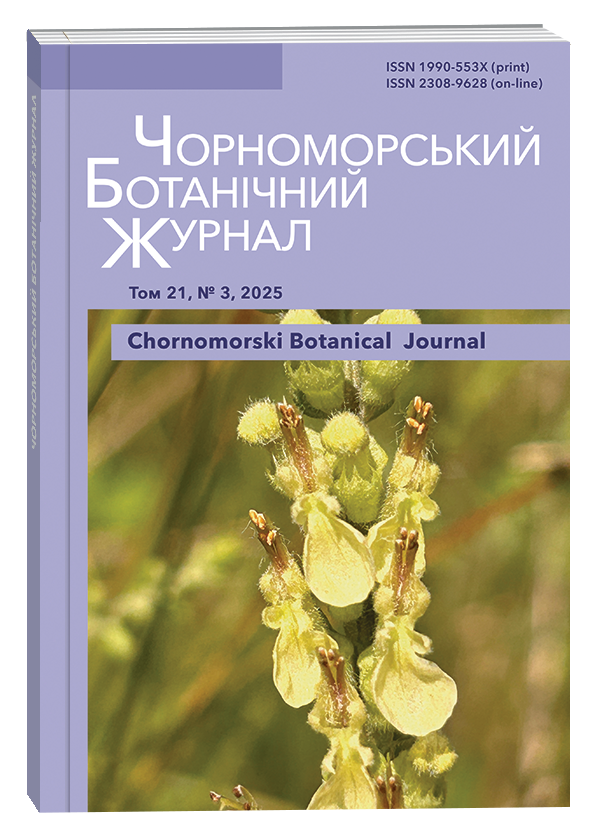Monitoring of baseline biodiversity, natural stands and dead wood in the habitats of oak-hornbeam forests of the Holosiivskyi National Nature Park
DOI:
https://doi.org/10.32999/ksu1990-553X/2025-21-3-6Keywords:
biodiversity, flora, bryophytes, fungi, lichens, animals, species, habitat, dead wood, forest, conservation, monitoring, plotAbstract
Question: What is the species composition of vascular plants, bryophytes, fungi (including lichens) and chordate animals on the monitoring plot of a natural oak-hornbeam forest in the Holosiivskyi National Nature Park? How do natural tree stands renew themselves, and how do dead woods change? Location: tract “Lisnyky” of the Holosiivsky National Nature Park, Kyiv, Ukraine. Methods: field observation Nomenclature:https://powo.science.kew.org/, https://www.indexfungorum.org/, https://zoobank.org/, Virchenko & Nyporko 2022 Results: The data on changes in biodiversity, natural regeneration and dynamics of dead wood in natural ecosystems of oak-hornbeam forests in the Vita River Valley of the Holosiivskyi National Nature Park are given. A total of 231 species of biota have been recorded on the monitoring plot (2.400 m2), including 8 species of trees, 3 species of shrubs, 39 species of herbaceous plants, 30 species of bryophytes, 93 species of fungi and slime molds, 44 species of lichens and 14 species of vertebrates. Among the detected bio¬diversity, 25 species of bryophytes and 7 species of lichens use dead wood as a substrate, 60 species of fungi are xylotrophs, 6 species of vertebrates feed on xylophage insects, and 3 species of vertebrates use dead wood as shelter. In the oak-hornbeam forest habitats of the park, Quercus robur and Fraxinus excelsior are in decline, with Acer campestre, Carpinus betulus and Tilia cordata predominating in the stand. The environmental factors that have been identified as crucial in determining the preservation, growth and development of the self-seeding and undergrowth of Q. robur include low light levels, dense undergrowth and the influence of wild boars, which have been shown to destroy the litter with germinating acorns. A rapid accumulation of dead¬wood reserves has been observed in the oak-hornbeam forest habitats of the Kyiv metropolis over the past five years, primarily attributable to the demise of Acer platanoides, F. excelsior, C. betulus and T. cordata. In contrast, the reserves of wood detritus of Quercus robur in the monitoring area have remained constant. The total stock of dead wood increased from 92.2 m3/ha in 2018 to 156.82 m3/ha in 2023, indicating the continuation of natural pro¬cesses in this area of the forest and its approximation to native parameters following conservation in 1989.
References
Bobiec, A. (2002). Living stands and dead wood in the Biaowiea Forest: suggestions for restoration managementin. Forest Ecology and Management 165 (1–3): 125–140.
Bilous, A.M. (2014). Methods of studying the mortality of forests. Biological resources and nature management 6 (3–4): 134–145.
Bilous, A.M., Kashpor, S.M. & Myronyuk, V.V. (2020). Lisotaksatsiynyi dovidnyk. Dnipro: Lira, 360 p.
Dymytrova, L.V. (2013). Lichens of the Lisnyky Botanical Reserve (Kyiv, Ukraine). Ukrainian Botanical Journal 70 (4): 522–534. (in Ukrainian)
Chernyavsky, M. & Izhyk, G. (2014). Dead wood in beech virgin forests as a complex of microhabitats for fungi. Lviv University Bulletin. Geographical series 45: 144–149.
Chornobrov, O.Y., Sotnyk, L.P., Khodyn, O.B., Konishchuk, V.V., Tymochko ,I.Y. & Solomakha I.V. (2020). Ecological assessment of the stock of dead wood in natural deciduous forests of the valley of the Vita River in the National Nature Park “Holosiivskyi”. Agroecological journal 2: 45–54. (in Ukrainian) https://doi.org/10.33730/2077-4893.2.2020.207680
Didukh, Ya.P. (2000). Ecological trail “Lisnyky”. K.: Tekhnodruk, 16 p. (in Ukrinian)
Didukh, Ya. P. & Chumak, K.V. (1992). The geobotanical characteristic of reserve “Lisnyky” (Kyiv). Ukrainian Botanical Journal 49 (6): 22–27. (in Ukrainian)
Didukh, Y.P. & Alyoshkina, U.M. (2012). Biotopes of Kyiv. Kyiv: Agrarian Media Group, 2012, 154 p. (in Ukrainian)
Kuzemko, A.A., Didukh, Ya.P., Onyshchenko, V.A., Sheffer, Ya. (eds.) (2018). National Habitat Catalogue of Ukraine. Kyiv: FOP Klymenko Yu.Ya., 442 p.
Mansourian, S., Vallauri, D. & Dudley, N. (eds.) (2005). Forest Restoration in Landscapes: Beyond Planting Trees, Springer, New York.
Onyshchenko, V.A. (ed.) (2017). Important Plant Areas of Ukraine. K.: Alterpress, 376 p.
Onyshchenko V.A., Pryadko O.I., Virchenko V.M., Arap R.Ya, Orlov O.O., Datsiuk V.V. (2016). Vascular plants and bryophytes of Holosiivskyi national nature park. K.: Alterpress, 94 p. (in Ukrainian)
Pryadko, O.I., Chornobrov, O.Y., Datsyuk, V.V., Virchenko, V.M., Zykova, M.O. & Andrievska, O.L. (2019). On the biodiversity of oak-ash forests of the Vita River valley and their role in the decomposition of dead wood on the territory of the Holosiivskyi National Park. In: Functioning of Protected Areas in Modern Conditions: Materials of the International Scientific and Practical Conference Dedicated to the 30th Anniversary of the National Nature Park "Synevyr" (Ukraine, Synevyr Village, September 18–20, 2019). Synevyr, 77–82.
SOU 02.02-37-476:2006 (2006). Trial forest management areas. Laying method. Kyiv: Ministry of Agrarian Policy of Ukraine.
Sukachov, V.N. (1972). Osnovy lesnoy tipologii i biotsenologii. L: Nauka, 419 p. (in Russian)
Virchenko, V.M. & Nyporko, S.O. (2022). Prodromus of Sporen Plants of Ukraine: bryophytes. K.: Naukova Dumka, 176 p. (in Ukrainian)




